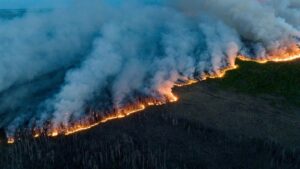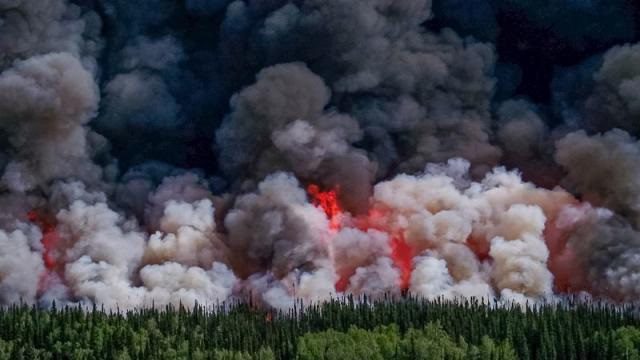Canadian Wildfires Engulf: Canadian wildfires have spread across the US, causing air quality alerts for 60 million people in 11 states. Chicago, Detroit, St. Louis, Cedar Rapids, and Cleveland residents have had poor visibility and air quality due to this situation.
A large part of the northern Plains, from Montana to Illinois, had an Air Quality Index of Level 4 on Sunday. According to the National Weather Service’s Weather Prediction Center, sensitive groups’ air quality will remain unhealthy throughout the week despite a gradual decrease in smoke concentration by Monday.
Canadian wildfire smoke is expected to haze the Northeast early this week. Satellite images from Friday, July 14, 2023, showed a large smoke plume entering the US, illustrating the ecological crisis.
British Columbia’s 400 fires over the past week caused this smoke. 51,000 thunderstorm lightning strikes caused almost half of these fires. Unfortunately, some of these thunderstorms were “dry” and failed to produce enough rain to extinguish the fires, worsening a dire situation in a drought-stricken province.
Unfortunately, these wildfires have a wider impact. A second Canadian firefighter died fighting the fires. A Fort Liard firefighter died Saturday after fighting a wildfire in the district, the Northwest Territories said in a statement. Another firefighter died in Revelstoke, British Columbia, earlier this week.
On Sunday, Canadian Prime Minister Justin Trudeau tweeted his condolences to the families, friends, and coworkers of these firefighters. Canadians stand united in this difficult time to honor their heroism.


READ MORE: Unveiling Crawford Lake: Earth Defining Moment of Human Impact
PM 2.5 particles in wildfire smoke pose health risks. According to the US Centers for Disease Control and Prevention, these particles can enter the lungs and bloodstream, causing respiratory issues, eye and throat irritation, and possibly lung cancer.
Unfortunately, weather patterns and Canadian fire intensification leave some US regions vulnerable to prolonged smoke exposure. Over 24 million acresroughly the size of Indianahave burned in Canada’s worst fire season ever.
British Columbia has had over 1,000 fire ignitions since April, burning nearly three times the average annual burn rate over the past decade. This shocking figure illustrates the province’s wildfire service’s dire situation.
As Canadian wildfires continue to ravage vast areas, millions of US residents face poor air quality and health risks. Communities across the border are working together to fight these fires and mitigate their long-term effects.
Also Read: China Military Surge: Rising Tensions Taiwan Security
Our Reader’s Queries
What is the status of the Canadian wildfires in 2023?
Canada experienced its most devastating wildfire season in 2023. The Canadian Interagency Forest Fire Centre reported a staggering 6,669 fires that ravaged 18.5 million hectares, surpassing the size of Florida.
Why are Canadian wildfires so bad?
Warmer-than-average temperatures and drought conditions are fueling Canada’s wildfires, according to Robert Scheller, a professor of forestry and environmental resources and the associate dean for research at the NC State College of Natural Resources.
Did Canada order evacuations as wildfires spread?
Over 15,000 homes have been ordered to evacuate as wildfires continue to spread across British Columbia. Premier David Eby declared a state of emergency statewide in response to the unprecedented fires on Friday night. The number of houses under evacuation orders in B.C. skyrocketed from 4,000 in the afternoon to more than 15,000 by nightfall.
Is the smoke from Canada toxic?
New research from Rutgers School of Public Health suggests that smoke from wildfires in Canada may pose a greater risk than car emissions. The study highlights the potential dangers of wildfire smoke on public health.

